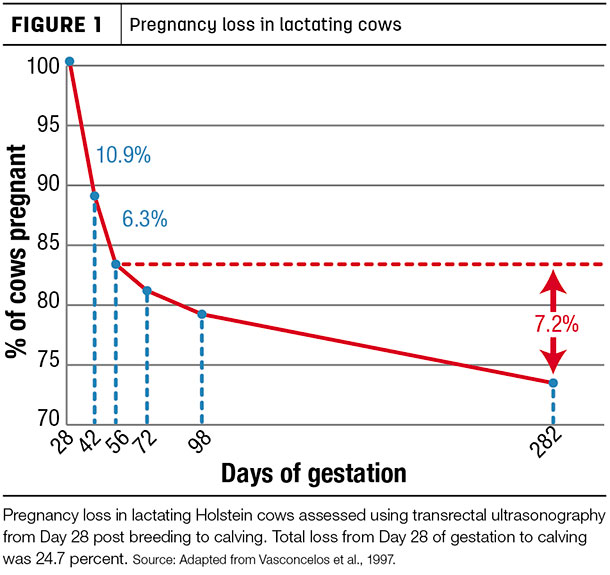The basis of a dairy’s profitability – calvings and subsequent milk production – depends on the successful detection of cows in heat and correct insemination (technique plus time).
This means dairy producers often search for ways to motivate employees and ensure the team puts special emphasis on this part of their work. This strategy helps underscore that reproductive success is a critical control point of the many processes on the dairy operation.
One of the methods to motivate employees is to offer bonuses based on specific benchmarks.
In my career as a veterinarian, and as a dairy reproduction consultant, I have had the opportunity to observe several plans for these bonuses. Some of these programs are successful and others – not so much.
I have worked with dairies that have based bonuses on:
- Cows in detected heat
- Inseminations
- Pregnancies at diagnosis
- Pregnancies at confirmation
- Fertility (conception rate)
- Pregnant cows in the herd
- Calvings
The intention behind these plans is very good. However, we must pay attention to the details because there are points within these programs that may not result in the ultimate goal: more calvings and more milk.
The following is an analysis of common bonus plans with their pros and cons:
Bonuses at the time of insemination
Bonus by cow in detected estrus. This bonus is paid when one of the designated employees indicates a cow and moment (time of estrus) in heat. Normally, it is given to a number of people on the farm.
- Pro: This program offers a way to increase the total number of inseminated cows by day, week or month, or some other timeframe.
- Con: This bonus has a problem. In an eagerness to get the bonus, people may wrongly identify heat, resulting in a wrong time of insemination. The effects of this can be seen at four to six weeks after a farm starts to diagnose pregnancies with very low fertility.
Farms may also see several cows with “double bleeding” – not because cows are in heat twice, but because people identified the same cow twice to get the bonus.
Bonus by insemination. This bonus is designed for technicians.
- Pro: At first it can work well, resulting in more breedings and more pregnancies.
- Con: It also carries the risk of inseminating more cows to false heats and lowering the herd’s reproductive performance/fertility.
Keep in mind while cost control is helpful, the dairy does not necessarily increase profits by lowering the semen bill every month. The farm earns money if it produces more milk. Therefore, if this practice increases the pregnancies by period, the dairy will have a successful result despite the low fertility.
The problem comes from the fact the farm will begin to lose effectiveness in its detection parameter, and people will tend to breed cows only to earn an amount of money.
In the medium term, this practice can hide a problem of anestrous cows. In addition, it can also hide the actual results from synchronization protocols.
Bonuses at pregnancy check
Bonus by fertility percentage. This is a bonus given if the inseminators exceed a certain percentage of fertility per period – for example, 30 percent fertility (conception rate) at service per month.
- Pro: None
- Con: This is a very dangerous bonus for the dairy since the inseminator often tends to breed only the optimum cows: those known to be in heat with perfect signs and optimal timing. They do so knowing they will have more fertility and fewer cows to breed.
When this bonus is paid very soon after the target time period elapses, the farm usually begins to record fewer inseminations and fewer pregnant cows per week.
Bonus by newly confirmed pregnant cows per period. This bonus pays for the number of new pregnant cows at every pregnancy check, usually once per week.
- Pro: This is a more real and useful parameter for the farm since a cow that is pregnant has a true risk to calve and generate a new lactation. Ultimately, it is required that people detect cows and inseminate them correctly to generate more new pregnancies.
Two variations may be considered for this bonus:
Newly pregnant cows at early pregnancy check
Pregnancy loss which occurs between early pregnancy diagnosis (less than 35 days following insemination) and confirmation diagnosis is a factor to consider when setting this parameter. Even normal losses during this timeframe are estimated from 12 to 15 percent.
Pregnant cows at the confirmation pregnancy check
By comparison, from confirmation at 60 days of pregnancy to calving, losses are estimated around 10 percent or less.

- Con: The issue with the bonuses at pregnancy check is trust in the method and the person who diagnoses. Unfortunately, I have witnessed situations where the person who diagnoses pregnancies allies with the inseminators.
They indicate high levels of success at the early pregnancy check and then corresponding high levels of embryonic losses at the 45- to 50-day pregnancy confirmation to attain bonuses for the crew. In addition to being dishonest, this practices causes a terrible uncertainty in the farm and team because the dairy begins to investigate other problems such as embryo losses by mycotoxins, heat stress, disease or other causes not the root of their problem.
Bonuses at calving. This bonus is based on fact.
- Pro: It is real, lasting, effective and directly related to the economic objective of the operation: more milk.
- Con: The most significant challenge with this bonus is: It takes nine months to pay out the first time. On one hand, the time it takes sometimes means new employees do not see the reason to put extra effort in correct heat detection and breeding of cows.
But if you can get employees past this concern, the bonus has a lasting effect on the farm. Once the nine months have passed, the bonuses are paid each month, which helps employees acquire a sense of permanence in the farm.
There are a couple of issues with the calving bonus. In the case of stillbirth, you may still pay the bonus. Because you are paying for fertility and, in most of the cases and particularly in large herds, the people who oversee the close-up and maternity pen are a completely different team than those in charge of breeding the cows.
What about abortions? The recommendation is for a late pregnancy test bonus, around 70 days after breeding, but there will be some additional pregnancy losses up until calving, around 5 to 10 percent depending on the farm and management.
For these later-term abortions, if the cow loses the pregnancy, the technician should lose the bonus. That sounds like a logistical nightmare to keep track of, but this can be accounted for beforehand to reach an adjusted amount of the initial bonus which accounts for late-term abortions.
For example, earlier in the article it was decided to pay $20 per every new cow pregnant at 70 days after breeding and $25 per every cow that calves. (Again, your farm’s values may be different.)
If you know you are going to lose 8 percent of pregnancies in cows after 70 days to abortions, here’s how a farm would calculate the adjusted bonus rate: If you have 8 percent of pregnancies abort from 70 to 280 days after confirmation, multiply the $25 bonus x 1.08 (108 percent of the total number of pregnancy confirmations) to arrive at the adjusted bonus offered to technicians – $27.
By choosing to pay the bonus adjusted for late-term abortions and stillbirths, you could now increase teamwork on the whole farm by tying the performance of one team (the reproductive team) to another (the close-up and maternity team).
A better bonus plan
In practice, I have observed that bonuses and reproduction can be effectively related. The ideal combination and the most valuable is to pay the bonus at the late pregnancy check or confirmation – at 70 to 80 days after breeding, for example – and add another bonus at calving.
In this plan, the employee has a relatively quick payoff before three months of the reproductive cycle. In my experience, that helps maintain good labor practices and motivates people to improve if they did not obtain any bonus. And the calving bonus adds permanence and long-term thinking to the team.
These two bonuses also have the advantage in that they are easy to audit and difficult to manipulate in a negative way. It is easy to find more people who can detect pregnancy at 75 days or greater. And at delivery, it is clear the cow was pregnant.
The combination of these two strategies have the strongest odds for increased animal productivity and employee satisfaction, which means success for everyone. ![]()

-
Hector Muñoz García
- SCR Dairy Manager – Mexico





